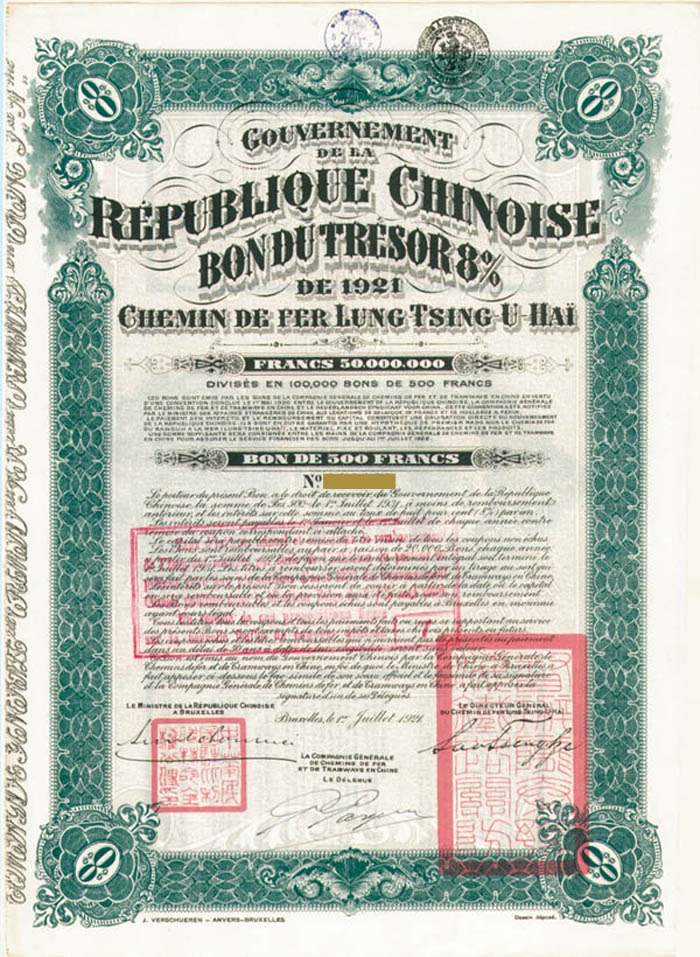500 Belgian Francs China-Lung-Tsing-U-Hai Railway - 1921 dated Green Railroad Bond (Uncanceled)
Inv# FB5056 Bond
China-Belgian Issue, 1921, Green with Red Overprint, 500 Belgian Francs (equivalent of £20), 8% Bond. Uncanceled. Has coupons.
Construction for this railway was from Lanzhou to Lianyungang. Lanzhou is the capital and largest city of Gansu Province in Northwest China. Located on the banks of the Yellow River, it is a key regional transportation hub, connecting areas further west by rail to the eastern half of the country. Historically, it has been a major link on the Northern Silk Road and it stands to become a major hub on the New Eurasian Land Bridge. The city is also a center for heavy industry and petrochemical industry. Read more at https://en.wikipedia.org/wiki/Lanzhou
Lianyungang is a prefecture-level city in northeastern Jiangsu province, China. It borders Yancheng to its southeast, Huai'an and Suqian to its south, Xuzhou to its southwest, and the province of Shandong to its north. Its name derives from Lian Island, the largest island in Jiangsu which lies off its coastline, and Yuntai Mountain, the highest peak in Jiangsu, a few miles from the city center, and the fact that it is a port. The name can be literally translated as the Port Connecting the Clouds. Lianyungang was home to 4,599,360 inhabitants as of the 2020 census whom 1,210,767 lived in the built-up (or metro) area made of Haizhou and Lianyun counties. Lianyungang was known in the West as Haichow (Postal romanization), which means the City of Sea. Haichow was opened to foreign trade by the Qing imperial government in 1905. Read more at https://en.wikipedia.org/wiki/Lianyungang
The Longhai railway, formerly romanized as the Lunghai railway, is a major arterial east–west railway in China. It runs from Lianyungang, Jiangsu on the Yellow Sea to Lanzhou, Gansu through the provinces of Jiangsu, Anhui, Henan, Shaanxi, and Gansu, covering a total length of 1,759 kilometres. The line is named after Gansu, also known as Long (?) in Chinese and Lianyungang's previous name, Haizhou. The Longhai Line is one of the busiest Chinese railways. It has dual tracks throughout the whole line, and the lines between Xuzhou, Jiangsu and Lanzhou, Gansu has been electrified.
The Longhai railway was built over the course of half a century by four different governments of China: the Qing Dynasty, Beiyang Government, Nationalist Republican government and the Communist government of the People's Republic. The first section of the railway, entirely within Henan, from Kaifeng to Luoyang was built from 1905 to 1909 by a venture between the Qing Dynasty and a Belgian joint-stock company backed by France and Russia. This line, known as the Bianliang–Luoyang railway, began operation on January 1, 1910. Read more at https://en.wikipedia.org/wiki/Longhai_railway
A bond is a document of title for a loan. Bonds are issued, not only by businesses, but also by national, state or city governments, or other public bodies, or sometimes by individuals. Bonds are a loan to the company or other body. They are normally repayable within a stated period of time. Bonds earn interest at a fixed rate, which must usually be paid by the undertaking regardless of its financial results. A bondholder is a creditor of the undertaking.










Ebay ID: labarre_galleries